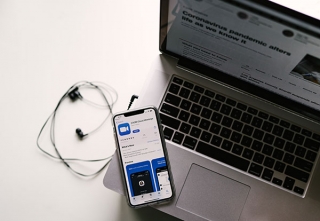
Zoom Fatigue Creeps into Lives
04 June 2020Kendall College Program Director Leigh Uhlir describes Zoom fatigue appearing in herself, students, colleagues and even family members.
By Lisa Parrish, GMC Editor
Have you heard of Zoom fatigue? It is the drained feeling of exhaustion and tiredness experienced after hours of video conferencing. People feel the fatigue effects not just after using Zoom but all video conferencing platforms.
In face-to-face communication the brain picks up communication information beyond the words being spoken, such as changes in facial expression, body language, and other non-verbal cues. During a video conference call, the mind is constantly trying to find all that same information from a small, dimly lit screen. The brain is literally working overtime.
Experts from around the globe are documenting and discussing this new effect of video conferencing. Kendall College program director Leigh Uhlir suggested this article for more information.
Uhlir describes her experiences with Zoom fatigue:
“We noticed around the second week of online classes students were fading out. They would come to one remote course but at the end the chefs and instructors stated they looked wiped out. We, ourselves as faculty and administrators, started to feel the fatigue from Zoom meeting after Zoom meeting.
“We then started to discuss with faculty that we needed to check in with our students. We do weekly student support meetings and surveys. The feedback told us we were doing too much. Even though the student would be in on-ground classes the same amount of lab time – or even longer – it (online) was different. And, the online work (assignments, readings, projects) was starting to feel overwhelming for the students.
“I think at first the students were so happy to be engaged with us but then all the work started to take its toll. So, we regrouped and made modifications to make some work required and some optional.
“I also noticed this happening in my two daughters who attend elementary school in Chicago and the amount of work that was being assigned remotely for them was overwhelming. The school also switched to required and optional assignments.”
I asked Uhlir for an example of modifications she and her team made to address Zoom fatigue. She referenced Kendall’s International Cuisine class:
“Prior to online instruction, a new cuisine was taught each class day. The class went for 20 days and had a five-hour lab class. We set the class remotely to be held once a week for 10 weeks and fit in two cuisines per week. This on-paper does not seem overwhelming, but with two or three other courses that students were taking too, we noticed the students were struggling. We decided to focus on one cuisine a week and the additional cuisines we left as optional extra credit. We also invited students to present cuisines that were not covered by creating a video to share with the rest of the class.”
You might also be interested in these stories about culinary instructors online teaching experiences during the past few months.
Click here to read the story “Online education’s remarkable moments.”
Click here to read “Teaching Online: The Good and The Ugly.”
Click here to read how culinary student Clare Ward started her own food cooking and delivery business when her classes and internship were cancelled.
Click here to read the story "Culinary Education’s Online Metamorphosis."
